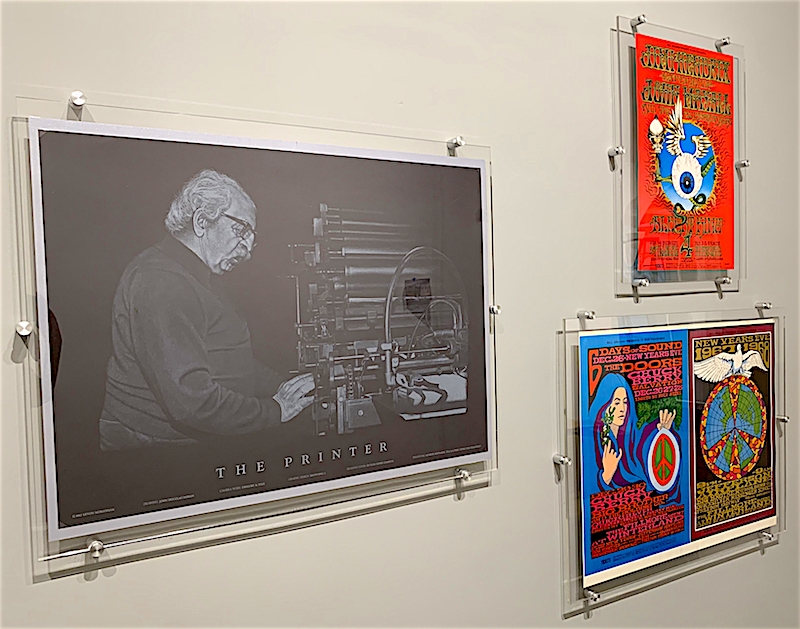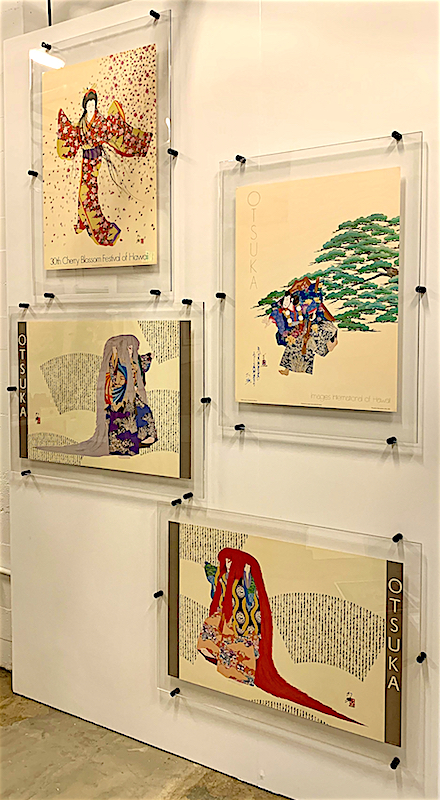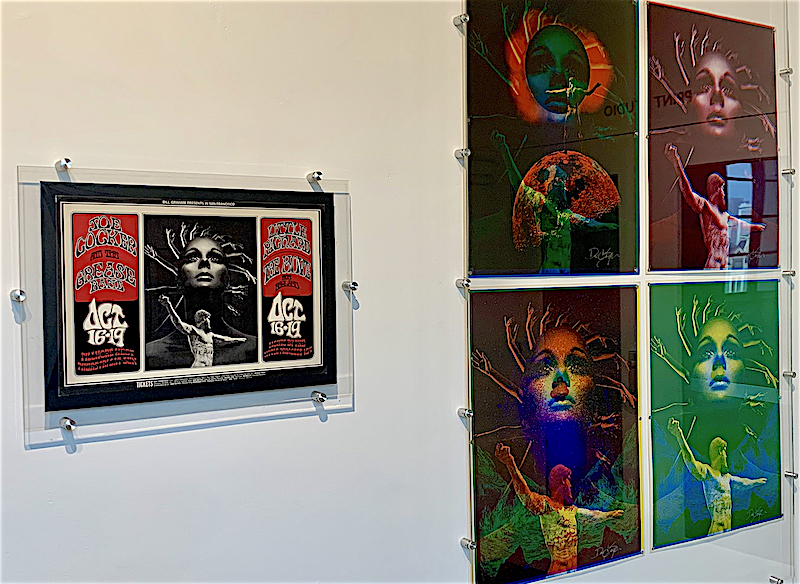
This portrait of Levon Mosgofian by John Douglas Moran was printed at Tea Lautrec by pressman Monroe Schwartz. To its right are posters by Bonnie MacLean and Rick Griffin.
Most rock-poster collectors probably conjure the same image when they hear the words “flying eyeball.” In their mind’s eyes, they immediately see Rick Griffin’s 1968 poster for a quartet of shows at the Fillmore and Winterland, headlined by the Jimi Hendrix Experience. An impressive subset of these aficionados can name the poster by its series designation, BG-105, and a healthy cohort of those can identify its printer, Tea Lautrec Litho, which they may even know was then called T. Lautrec Litho. But only a relative sliver of rock-poster enthusiasts are familiar with the name Levon Mosgofian, the owner of the union shop that printed Griffin’s iconic flying eyeball, and it’s a safe bet that fewer still could properly pronounce the legendary printmaker’s name.
Now through November, the Haight Street Art Center is presenting a pair of exhibitions designed to bring Mosgofian out from the shadows cast by BG-105 and other Hall of Fame-worthy rock posters printed at Tea Lautrec. The first, “Grand Legacy: Levon Mosgofian & Tea Lautrec Litho, Radical Roots & Rock Art,” explores Mosgofian’s life and interests before, during, and after his print shop’s Fillmore heyday. A second exhibition upstairs, “After Hours: The David Singer Sessions,” focuses on exploratory prints the Fillmore’s most prolific artist produced on weekends with Tea Lautrec Litho pressman Joe Buchwald.

Via family photos, rare examples of Mosgofian’s original art, newspaper clippings, and, of course, lots and lots of posters, “Grand Legacy” traces Mosgofian’s rough-and-tumble roots in Fresno, his printing apprenticeship in Los Angeles, and his arrival in the early 1930s in San Francisco, where the Depression and the General Strike of 1934 radicalized him to the cause of worker’s rights. Mosgofian’s activism led him to embrace many of the political causes of the 1960s, including strikes by farmworkers, for which he produced numerous posters. But if Mosgofian was known in some quarters as an activist, he was widely recognized for his skill as a printer and the excellence of his shop’s work, which is why he landed some very big accounts, as evidenced by the David Lance Goines poster Tea Lautrec printed for Bay Area Rapid Transit.
As you’d expect, “Grand Legacy” includes numerous posters printed for Bill Graham-produced concerts at the Fillmore, Fillmore West, Winterland, Cow Palace, and Oakland Coliseum—the exhibition does a good job of telling the story of Mosgofian’s transition from employee of Neal Stratford & Kerr to owner of T. Lautrec. Seeing these prints is like hanging out with old friends at a party. Happily, the party at Haight Street Art Center includes many new faces, too, including posters of San Francisco by Carlos Martinez, cable cars by John Russell Wullbrandt, sports cars by Harold James Cleworth, art posters for exhibitions by Frida Kahlo and Diego Rivera, and a stunning collection of work by Hisashi Otsuka.
While the subject matter of these posters is diverse—it’s a very long way indeed from Wullbrandt’s cable cars to Griffin’s flying eyeball—Mosgofian and his fellow pressmen and women at Tea Lautrec lavished attention on all of them, gaining a reputation for their willingness to go the extra mile with artists to help them realize their visions. That willingness is seen throughout “Grand Legacy,” as well as in the Haight Street Art Center’s upstairs gallery, where visitors will find a smaller exhibition of prints produced by David Singer and Tea Lautrec pressman Joe Buchwald.

Of all the artists who passed through Tea Lautrec, Singer was unique. It was Singer, after all, who suggested to Mosgofian that he change the name of his shop from T. Lautrec to Tea Lautrec, “tea” being Jazz Age slang for marijuana. Mosgofian agreed. And because Singer received more assignments from Bill Graham than any other artist during the Fillmore era, he was a familiar face at Tea Lautrec, often working with Mosgofian until the wee hours to ready one of his posters for printing by one of Tea Lautrec’s pressmen the following day. That’s why it may not have seemed like much of a stretch for Mosgofian to greenlight Singer’s weekend sessions with Buchwald, which occurred between 1971 and 1973 over numerous non-consecutive weekends.
The prints the artist and pressman created were built from enlarged collages Singer had designed for concerts headlined by Steve Miller, Moby Grape, and many other bands. These enlarged collages were printed in all sorts of colors before being mixed and matched with other collages to create collages of collages. Singer and Buchwald would try something, try something else, and then do it all over again, without regard to the wear and tear on Mosgofian’s presses, the cost of ink, or other legitimate business concerns. It’s difficult to imagine this body of work being produced anywhere else but at Tea Lautrec, which itself is a testament to Levon Mosgofian’s unparalleled legacy.
(“Grand Legacy: Levon Mosgofian & Tea Lautrec Litho, Radical Roots & Rock Art” and “After Hours: The David Singer Sessions” continue through November at the Haight Street Art Center.)
Ben, you have a gift. You captured nicely the nature of Levon and Tea Lautrec. I worked in many printing plants and at the Chronicle/Examiner, and not one had the essential character of close cooperation and nurturing.
Denis Mosgofian